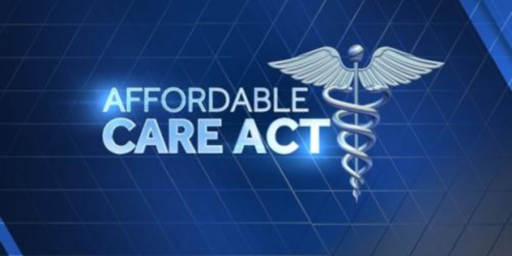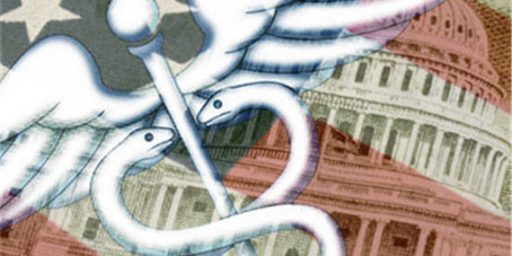Malpractice Insurance
One of the issues regarding the cost of health care is the role that malpractice insurance plays in the cost of health care. Malpractice insurance premiums are going up quite a bit. Some say this is due to runaway juries making outrageous awards (e.g. President Bush). Others say it is the greed and avarice on the part of malpractice insurance companies that is too blame (see Kevin Drum as a prime example). However, Alex Tabarrok has a couple of interesting observations for the latter group,
According to Independent Institute Research Director Alex Tabarrok, those who are quick to believe that insurer “greed” is the culprit must answer some troubling questions. If, for example, profits are easily earned by jacking up premiums, then why did a major medical malpractice insurer leave the market last year? And if doctors are being gouged by greedy insurers, what does one make of the rise of premiums of policies written by doctor-owned insurance companies? The reason behind these seeming anomalies is that premiums do in fact reflect awards — albeit imperfectly, because insurers can’t always tell quickly whether an increase in awards is a temporary blip or a permanent trend.–emphasis added
These two bits of data argue against the simple hypothesis of insurer greed. My guess is that perhaps, there isn’t a simple answer to this problem. Perhaps one of the culprits is the government. Government is one of the few entities out there that can make effective barriers to entry for a market. Once barriers to entry come into existence those firms already in the market gain market power which allows them to raise both their prices (premiums in this case) and their profits.
There is also this bit of information as well,
The latest study by Tabarrok, co-author of JUDGE AND JURY: American Tort Law on Trial, shows that “during the last 30 years every dollar increase in awards has led to a dollar increase in premiums.” However, in the 1990s increases in malpractice insurance premiums apparently were not high enough to cover the increase in tort awards — a mistake that insurers have been trying to rectify in recent years. Another complication: Awards have increased much more in states where judges are elected — and therefore have incentives to cater to many voters’ redistributionist leanings — than in states where judges are appointed.
We all know that politicians at the city, state and federal level will use pork barrel spending to help in their re-election bids. Seems reasonable to look for similar type of behavior on the part of judges, call it pork barrel rulings.
Also, one of the problems with insurance is trying to find out if an unexpected increase in claims is permanent or transitory. Insurance companies deal with events that, a priori, are considered random. In this case, the number of claims. It is possible, that the number of claims is high just due to bad luck. It is also possible that the number of claims has gone up permanently for another reason. For example, if there is a law or a major court precedent that makes it easier to win in court, then claims could concievably go up.






The premise of this argument is false. Malpractice awards have been flat since 1991 and down since 2001. Total payouts in constant dollar terms were $2.38 billion in 2004 versus $2.18 billion in 1991. Peak payouts were in 2001. Payouts per 100k people were lower in 2004 (4.91 per 100k) than any year 1991 or later. The number of “jackpot” payouts in excess of $1 million declined from 2.25/100 to 1/100 over the 1991-2004 period.
Meanwhile, malpractice insurance rates have skyrocketed. The reason? Insurance companies lost tons of money in the 1999-2001 stock market, and they need to recoup their losses.
If Tabarrok is correct and awards have “increased much more” in states with elected judges, that must mean that the other states have sharply declined. There’s no other way to make the math square with reality.
jwb,
I’d love to see your data sources. Most data sources I’ve seen have been either partial (i.e. it includes doctors but leaves out other health care workers such as nurses or it looks only at payouts for cases that went to court) or showing percisely the opposite.
On the elected judges having higher awards.
If you think about who contributes to judges campaigns (mostly lawyers), then you can see the potential for impropriety. It can be subtle, but very real.
A simple solution would be to have lawyers or members of their firms be ineligible to appear in cases before judges they have donated to. You would have to expand it to law firm staff and their families. Now the judges wouldn’t have the incentive. Total amount of money would likely go down for judges campaigns, but it should be a draw down for both sides.
In Houston, one of the issues is judges rulings on “gay issues”. Because the Houston gay community is organized, they can have a disproportionate impact on elections if what would other wise be a “no account case” runs foul of what they consider their interests. But that is citizens organizing for a political end. If you don’t like it, organize enough citizens on the other side to dis-elect judges who pander to the gay community. That is what elections are supposed to be about. Who is going to do the best job as you the voter see it. And there’s nothing wrong with organizing around it.
Steve Verdon: this data comes from the National Practitioner Data Bank (NPDB), which was formed by an act of Congress, available at http://www.npdb-hipdb.com/npdb.html . I believe this database includes all practitioners, including nurses.
Curse those communistic voters!
jwp,
Well, in looking at the data from 1996 to 2004 you are right, in inflation adjusted terms the total number of payouts for doctors is indeed flat.
However, the average size of payouts increases each year by about $8,000. So in terms of the average payout you are incorrect.
I haven’t looked at the data for physicians assitants and nurses yet.
Further, I’m curious…the data on the website so far appears to go back to 1996, how did you get 1991?
the normal economics of F&C insurance is to lose money on the insurance side of the operations and to make it up on the investment side. the rational for operating such a company is that it is a way to leverage you capital in the stock market. I do not have the expertise on the
particular market, but given my general knowledge of the industry my initial bias is to blame most of the increase in premiums in recent years to low stock market returns rather then
higher settlements.
the way the system works is that the capacity of the firms to write insurance is a function of their capital. So if you have a major bear market that leads to a reduction in the capital of the industry the industry shifts into a very short supply situation that allows firms to raise premiums. Normally the growth in stock and bond returns allows the total capital in the industry to grow so that the firms all have so much capital that competition keeps prices low.
Finally, the firms are generally regulated on a state basis and they are all the time different firms moving in and out of specific markets. So without more information the fact that a major malpractice insurance company left the market last year is completely irrelevant. Was he referring to all 50 markets or one state market?
Maybe the reason that firm left the market was the impact of the bear market on their capital was such that they had to shrink the size of the firm. I do not know the answer, but the article does not provide it either. The author wants you to draw certain conclusions, but he does not provide enough information to support that conclusion.
Uhhhmmm no. The explanation is left as an assignment.